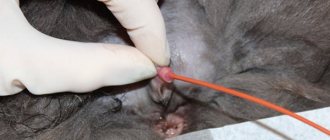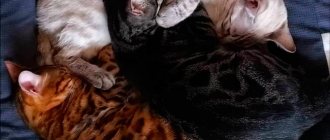Origin of the species and description
Photo: Jungle cat
The jungle cat has been known since ancient times; the Egyptians called it “Nile cat”. It was they who first tamed it, this happened more than three thousand years ago. They went duck hunting with this interesting predator. This became known thanks to the found rock paintings, which show cats swimming with prey to people. The cat also acquired its second nickname “house” from the Egyptian people; it is translated as “house”, because this cat lived in their houses.
These cats used to be popular pets in 25 different countries around the world, although their reputation was often questionable. For many, the house remained a wild and dangerous predator, which was not averse to feasting on poultry, so it was feared in the villages. One of the first to describe this type of animal was the traveler and naturalist Johann Anton Güldenstedt, who was in the service of Catherine II during his expedition to the southern borders of the Russian Empire, this happened in 1776.
Still, in those days there were cat lovers and they bred a new breed, very similar to the jungle cat, but not so aggressive and wild. This was achieved by crossing an ordinary domestic cat and a Nile cat. The bred breed was named “Felis chaus”, it was believed that they had a more docile disposition.
Then other hybrids were bred, almost no different in appearance from the jungle cat, but with a more meek character. Now the world is inhabited by 10 varieties of swamp lynx breeds.
Appearance and features
Photo: Wild jungle cat
Compared to an ordinary cat, the reed cat has much larger dimensions. The body of a wild cat is from 60 to 90 cm in length, not counting the tail, which reaches up to 30 - 35 cm in length. The weight is also quite large - from 5 to 12 kg. The cat reaches half a meter in height at the withers. Smaller cats inhabit Thailand and the island of Sri Lanka, and the largest ones are seen in the Caucasus and Palestine.
It is not for nothing that the jungle cat is associated with the lynx, because its entire appearance clearly resembles it, both in color and in the funny black tassels on its ears. The color of the cat is grayish-sandy, similar to the color of dry reeds. There is a slightly pronounced pattern on it in the form of dark spots or stripes; it is more noticeable in young individuals and cubs, mainly the stripes are located on the paws and tail. The cat's fur is short and rough. In summer it sheds heavily, and by winter it becomes densely packed and very thick.
The color tone of Nile cats may differ slightly, it depends on the region of their habitat, it can be:
- light sand;
- reddish yellow;
- light brown;
- greyish yellow.
The paws of jungle cats are very powerful, strong with large sharp claws. The reed cat's muzzle is round and elongated towards the bottom, of medium size relative to its physique. The external features of the Nile cat are fully consistent with all cats, and the color of the coat allows it to easily blend into the natural landscapes of the places where it lives.
Cat Chausie
There is a special, new breed, bred by crossing a wild reed breed (males only) with a regular cat - Chausie (Chausie). Externally, the pet is very similar to its father, but there are differences:
- the tips of the ears and tail are strictly black:
- smaller dimensions, weight;
- elongated tail.
It is more difficult to train such a cat to use a litter box, but its character is more flexible; with proper training, they become excellent companions. The parent’s genes make themselves felt with similar signs:
- love of open spaces;
- sociability;
- passion for bathing;
- large dimensions.
The distinctive features of the domestic version of the reed breed are reflected in physiological signs:
- hybrids have sensitive stomachs, it is strictly forbidden to feed your pets pork and grains;
- sterility of males until the third generation.
Where does the jungle cat live?
Photo: Jungle cat in nature
Jungle cats love warm climates, which is why their favorite places of residence are Central Asia and the Caspian coast. They also live near the rivers of Africa (Nile), in Thailand, on the island of Sri Lanka, in Palestine, India, Indochina, in eastern Eurasia, and in the Caucasus. On the territory of the Russian Federation, in addition to the Caspian Sea, they can be found in Dagestan and in the lower reaches of the Volga River.
Cats hate open areas, so they go there in rare cases, without going far from their place of permanent deployment. Cats love bushes and reeds, where they feel most at ease and safe. Seals love to settle in coastal shrub and reed areas. Houses are not at all keen on building their homes, but prefer to settle in empty fox and badger holes. They do not live in them for a long time, constantly moving to new places for safety reasons. You can see cat tracks on the shore; jungle cats leave them on the shallows. They swim and dive beautifully, hunting both aquatic birds and fish.
If a cat lives in a mountainous area, then it does not like to climb higher than 800 - 1000 meters, preferring its bushy, often thorny wilds. The cat doesn’t particularly want to have contact with people, leading a secretive and cautious lifestyle. During winter cold and early spring, it can visit human villages, carrying out bandit raids, with the aim of stealing poultry, which it loves to feast on.
What does the jungle cat eat?
Photo: What a jungle cat looks like
We can say that the jungle cat is an omnivore that feeds on almost everything that comes under its clawed paw. He is not averse to feasting on birds, catching them in flight; eggs from nests also form part of his diet. The cat also catches all kinds of rodents (field mice, gophers, martens), sitting by the mink for hours waiting for prey. The cat will not refuse all kinds of insects and even amphibians; it can eat frogs, lizards and snakes. A jungle cat can get itself a white hare, or even a small wild boar, if the opportunity arises. Hunts for birds that live on the water, catches fish. It is no coincidence that he dives and swims beautifully.
It’s worth focusing on how interestingly the cat catches fish. He slowly slaps his paw on the surface of the water, creating the impression of a floundering insect, luring the fish. If it swims up, it immediately gets hooked by its sharp claws that are deftly released. To fish it out, the cat plunges its head directly into the water.
The house goes hunting as soon as it begins to get dark. It watches over prey and acts almost silently; with one graceful leap it can overtake its prey, which it skillfully and lightning-fastly strangles.
Among rural residents, the cat is known as a robber and thief who invades chicken coops, steals chickens and other poultry, and can even steal a small pig. True, the jungle cat does not do all this so often, because... prefers not to come close to human settlements. Basically, robberies occur in the cold winter and early spring, when it is difficult to obtain food.
Features of character and lifestyle
Photo: Jungle cat in the wild
The reed cat loves to settle near various bodies of water, choosing their dense bushes and reeds. He always behaves very carefully and quietly, trying not to make unnecessary noise and acting like a real experienced spy. The animal tries to avoid open areas. The cat does not like to climb trees, although it has powerful paws and sharp claws.
Hunting is second nature for the jungle cat; he behaves both boldly and very carefully so as not to scare away the prey. The cat is most active at dusk, and during the day it likes to rest in thickets or a hole.
Excellent eyesight and acute hearing help the swamp lynx not only to hunt successfully, but also to avoid being caught by ill-wishers. If a collision with an enemy is inevitable, the cat behaves courageously and aggressively, showing all its strength and power. An interesting feature of the jungle cat is that it loves to dive into water not only for the sake of hunting, but also in order to wash off its scent. This distinguishes him from domestic cats, which, on the contrary, like to leave it everywhere.
House loves to live alone on his territory; he starts a family only for a short mating period. The cat loves to have his own space where he feels free and serene. The territory of such a habitat can occupy from 50 to 180 square meters. km. Another interesting quality of the jungle cat is composure and patience. A cat can sit quietly for hours near its prey's hole, showing incredible patience and endurance.
It is possible to domesticate a predator, but it is a very labor-intensive task that requires great desire and diligence, because... The animal is very freedom-loving and independent, and has a rather stern disposition. Even small kittens stubbornly hiss and snort, showing their rebellious and tough character from childhood. It is worth noting that a domesticated jungle cat can recognize only one person as its owner, and will treat the rest of the family with caution and even aggression.
Predator habitats
Cats that do not like open areas prefer to avoid the desert and steppe. Also, predators do not like to climb trees. They rarely do this. Animals differ from other representatives of the cat family in that they can swim well and are not at all afraid of water.
The habitats of the swamp lynx are:
- dense thickets of thorny bushes;
- reed supports;
- sea shores;
- floodplains;
- wooded areas located near water bodies.
The predator does not climb the mountains because it cannot tolerate low temperatures.
Social structure and reproduction
Photo: Jungle cat
Reed cats like to live completely alone, creating families only during the mating season, which usually occurs in February - March. At this time, animals are very aggressive and formidable. Like ordinary cats, they emit a loud inviting meow and engage in fierce battles for possession of the female. After mating, the cat takes care of a cozy place where her den will be located. Usually, it is located in the most impassable thicket of bushes. The female makes a flooring from branches, reeds, found feathers, and wool to make the kittens warm and comfortable.
Pregnancy lasts not much more than two months. Typically, three to six babies are born. The litter is often dominated by males. The weight of newborn kittens ranges from 60 to 100 grams. At birth, they are completely blind, and their eyes open after about 10 days. Their color is much brighter, the pattern is more pronounced than in adults.
The mother carefully cares for the babies, feeding them with breast milk until the age of three months, although from two months of age she introduces other foods into the diet. The male also participates in raising and feeding, always being nearby. From the age of five months, the young animals show their independence, and by eight months they become sexually mature. In the wild, the life expectancy of a jungle cat is 14–15 years. In captivity they can live a little longer and reproduce quite well.
Natural enemies of jungle cats
Photo: Wild jungle cat
In nature, the jungle cat is threatened by larger predatory animals. For example, a leopard often attacks them, regardless of the fact that they are also a cat breed. The main enemies are jackals, foxes and wolves. Usually the jungle cat deftly and quickly runs away from them, because their strengths are not at all equal. To escape, he can climb a tree using his sharp claws, and thus outwit the foxes and wolves. With the help of jumping, the cat can easily move from one tree to another in order to escape from larger predators.
One of the main dangers for the existence of this species of animals is a change in their places of permanent residence. This could be the disappearance of bodies of water, barbaric deforestation, poor environmental conditions, or human development of wild cat habitats. People involved in hunting are not interested in the jungle cat; its fur is not valued at all; it can be caught completely by accident.
But people often exterminate jungle cats because they attack poultry, stealing it right from the farmyard. There are no other reasons for capturing these animals, but they are enough to reduce the population size. So, in Russia the reed cat is listed in the Red Book.
Mr. Cat recommends: features
In nature, the house lives in thickets of bushes and reeds growing along the banks of water bodies; it is an excellent swimmer and fisherman. These are due to his love for water and at home.
In addition, water procedures allow them to keep their thick fur in order; House does not emit a specific cat smell, unlike other representatives of domestic cat breeds. Therefore, it is worth taking care of organizing a place for the animal to bathe.
This is a very devoted and faithful creature, but he will not sit on his lap if he does not want to. It is worth considering the peculiarity of this type of cat and not keeping it in families with small children. They will unnecessarily irritate the pet with their increased attention, and he, in turn, can cause injury to them (do not forget about his size and wild past).
At the same time, the animal feels absolutely comfortable in the vicinity of dogs, provided that they also do not show particular persistence in communicating with him. If the family has birds or rodents, you should take care of their safety, as the house will hunt them.
Thanks to their fairly high intelligence and memory, these large cats easily open doors and remember where the things that interest them are. Due to their flexibility and developed muscles, they often use furniture as sports equipment, while climbing to the very top. So it is useless to hide objects from them on cabinets and shelves - they will climb into them with ease and even pleasure.
This is a very kind and obedient animal, requiring, like other representatives of cats, care, attention, affection and care.
Population and species status
Photo: Jungle cat in nature
The secretive and very cautious life style of jungle cats does not provide complete and clear information about the status of their population as a whole, so a situation in this regard is not entirely clear. It is reliably clear that its species is under threat of extinction in numerous areas of its permanent residence, especially in the southwestern and southeastern parts of Asia.
It is known that all jungle cats are listed in the second appendix of CITES (special international convention on trade and protection of endangered species of animals). In many Indian and Afghan states it is prohibited to destroy and sell them. The Caucasian subspecies, living in Russia, is listed in the Red Book. It can be found in the territories of Ossetia, Chechnya, Ingushetia, the Caspian coast, and in the lower reaches of the Volga.
According to reliable information, it is known that the reed cat was last seen on the Caspian shores back in the eighties of the twentieth century, although old-timers claim that they are sometimes seen even now. Rare encounters between people and this wild cat increasingly prove the fact that this animal has sharply reduced its population in various ways and in many countries, including ours, is on the verge of extinction, which cannot be allowed.
Life in captivity
Many exotic lovers dream of taming an indomitable predatory animal as a pet. Jungle cats, with their wild beauty, amazing grace and contradictory character, make you want to buy them for any money. Before you decide to buy a house, you need to weigh the pros and cons. There are several aspects to consider:
- The marsh lynx is listed in the Red Book of Russia and is under state protection. You need to purchase an animal only from professional breeders and be sure to check for a veterinary passport.
- Keeping a jungle cat requires a significant investment.
- The animal should be provided with conditions similar to those in nature.
- House recognizes only one owner. Ignores other family members or shows aggression towards them.
- A jungle cat may not live up to the owner’s hopes and will forever remain a wild, uncontrollable animal.
Do not forget that in nature the territory of each individual is several hundred square kilometers. Therefore, it is advisable to keep a cat not in an apartment, but in a country house, where there is plenty of space for a mobile animal. It is better to build a large indoor enclosure, fenced with a strong metal mesh. The dimensions of the fence must be impressive so that the animal feels comfortable staying in it. The floor can be covered with dry reeds or reeds.
The swamp lynx, which lives in a city apartment, needs to be walked periodically so that the animal receives the required dose of ultraviolet rays. It is advisable from time to time to give the jungle cat the opportunity to swim in a natural body of water.
Do not delude yourself that an adult will allow itself to be tamed and become a cute domestic cat. Almost all attempts to subdue an animal accustomed to living in the wild have failed. Only a kitten under 3 months of age can get used to its owner and become a pet.
Jungle cats have very good immunity and excellent health. But to avoid problems, your pet should be vaccinated. For cats kept in apartment conditions, you must purchase:
- tray corresponding to the size of a large cat,
- special filler,
- large scratching post
- comb for combing wool,
- toys to entertain an inquisitive animal.
The house gets used to the litter box quickly and does not require constant brushing and bathing. But it needs increased attention, affection and constant joint games. If the owner pays little attention to the obstinate animal, the kitten may get bored and even get sick. The jungle cat is a big owner. He is jealous of the chosen owner of other household members and animals living in the same territory.
Feeding of the swamp lynx living in captivity
First of all, it is worth remembering that the domesticated housefish still remains a predator, so it should eat mainly meat. Certain rules must be followed:
- kittens up to one year old are fed twice a day, adults - once,
- Plant foods should be added to the menu,
- Give the animal special vitamins and minerals.
Daily diet:
- 200 grams of lean meat (chicken loin, beef, veal) and two mice or one rat,
- fish once a week
- a third of the menu should consist of vegetables.
To prevent a predatory pet from becoming obese, he is given a fasting day once a week. It is not recommended to feed your Hausa cat food or cereal porridge. They contain a lot of fiber, which the Nile cat’s stomach does not digest well. Food from the master's table is also unsuitable food for an animal.
However, even ideal conditions do not guarantee that at a certain time instincts will not take over. The most dangerous period is the mating season. At this time, the animal becomes aggressive and uncontrollable. As soon as the animal reaches puberty, it needs to be castrated or matched. An Abyssinian or other short-haired cat would be suitable. From this union both common and reed kittens are born. Differences appear by three months.
For those who dream of owning a wild cat from the reed thickets, there is an alternative - Hausie cats. They get along well with humans and have a quite friendly character.











